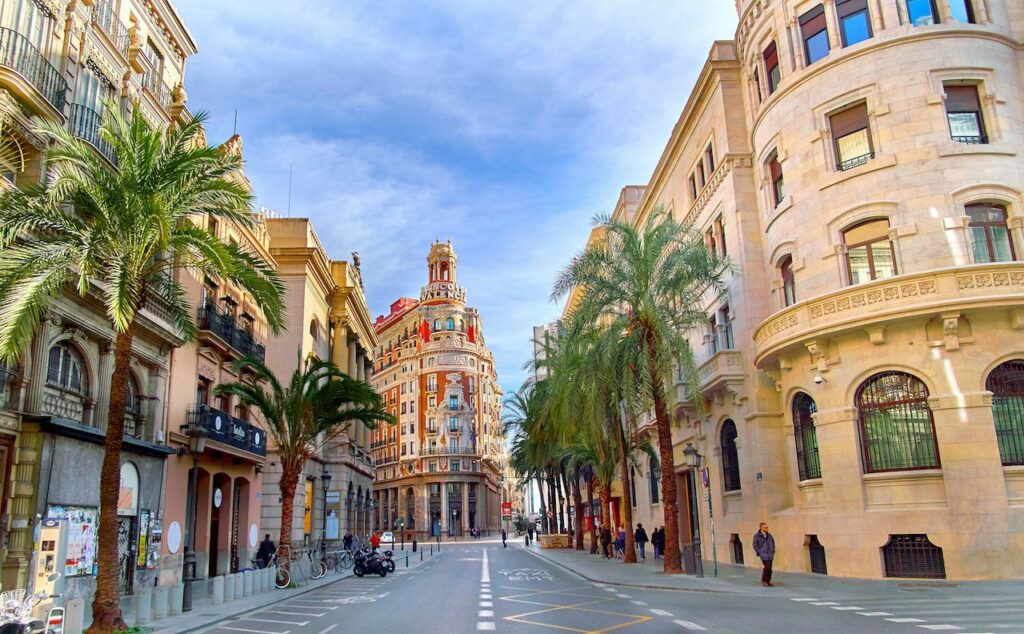Valencia, Spain: A Tapestry of Heritage, Arts, and Coastal Charms

Nestled along the sun-soaked eastern coast of the Iberian Peninsula, where the Turia River gracefully meets the Mediterranean Sea, lies the enchanting city of Valencia. This Spanish jewel, the third-largest city in the country, beckons visitors with its rich historical legacy, avant-garde architecture, and a vibrant cultural scene. Join us on an immersive journey through the cobbled streets, historic landmarks, and coastal wonders that define the captivating allure of Valencia.
Historical Echoes and Architectural Marvels:
Valencia’s history is a narrative that unfolds through the ages, blending Roman, Moorish, and Christian influences into a harmonious cultural mosaic. The city’s iconic symbol, the Torres de Serranos, stands as a testimony to its medieval past. These ancient towers once formed part of the city’s defensive walls and offer panoramic views of Valencia’s historic center.
The Silk Exchange, or La Lonja de la Seda, a UNESCO World Heritage site, showcases Valencia’s prosperity during the 15th century. This Gothic masterpiece, with its ornate columns, intricate carvings, and stunning frescoes, reflects the city’s significance as a trading hub during the Golden Age.
The Valencia Cathedral, dedicated to Saint Mary, is a captivating blend of architectural styles, including Romanesque, Gothic, and Baroque. The Miguelete Tower, rising majestically from the cathedral, rewards climbers with breathtaking views of the city.
The City of Arts and Sciences:
Valencia’s skyline is transformed by the futuristic structures of the City of Arts and Sciences, a cultural and architectural marvel designed by Santiago Calatrava and Félix Candela. L’Hemisfèric, an eye-catching planetarium, and the futuristic opera house, Palau de les Arts Reina Sofia, redefine Valencia’s architectural landscape. The Umbracle, a landscaped walkway, and the Oceanografic, Europe’s largest aquarium, complete this cultural complex, forming a symbolic convergence of science, art, and entertainment.
Turia Gardens and the Bioparc:
Valencia’s commitment to green spaces is embodied in the Turia Gardens, a lush oasis that spans the former riverbed of the Turia River. This expansive park offers locals and visitors alike a respite from urban life, featuring walking trails, playgrounds, and serene gardens. The City of Arts and Sciences seamlessly integrates into the Turia Gardens, creating a harmonious blend of nature and modern architecture.
The Bioparc Valencia, located within the Turia Gardens, presents a unique zoo concept that immerses visitors in recreated natural habitats. This conservation-focused zoo provides a close encounter with diverse ecosystems, allowing guests to appreciate the beauty and diversity of wildlife.
La Albufera and Coastal Charms:
Just a short drive from Valencia lies La Albufera, a vast natural lagoon and wetland area that reflects the region’s ecological diversity. The freshwater lagoon is surrounded by rice paddies, creating a picturesque landscape that has become an essential part of Valencia’s culinary heritage. Boat trips on the lagoon offer a tranquil escape, providing glimpses of local flora and fauna.
Valencia’s coastal charms extend to its beautiful beaches, including Playa de la Malvarrosa and Playa de las Arenas. These sandy stretches invite sunbathers, water sports enthusiasts, and those seeking seaside relaxation. The lively waterfront promenade, Paseo Marítimo, lined with restaurants and cafes, becomes a vibrant hub as the sun sets over the Mediterranean.
Culinary Delights and Paella Tradition:
Valencia is synonymous with paella, the iconic Spanish dish that originated in the region. Traditional paella valenciana, featuring rabbit and chicken, is a culinary masterpiece that showcases the city’s agrarian heritage. Seafood paella, incorporating fresh catches from the Mediterranean, adds a coastal flair to this beloved dish.
The Central Market of Valencia, Mercado Central, stands as a gastronomic haven where locals and visitors can explore stalls brimming with fresh produce, spices, and regional delicacies. From cured meats and cheeses to vibrant fruits and vegetables, the market reflects Valencia’s commitment to culinary excellence.
Festivals and Cultural Celebrations:
Valencia is renowned for its vibrant festivals, infusing the city with energy and color. Las Fallas, held annually in March, is a world-famous celebration featuring elaborate sculptures, parades, and fireworks. The festival culminates in the burning of these intricate sculptures, symbolizing the triumph of spring over winter.
La Tomatina, a tomato-throwing festival in the town of Buñol near Valencia, attracts participants from around the world who revel in this unique and lively celebration.
Historic Neighborhoods and Modern Vibes:
Valencia’s historic neighborhoods, such as El Carmen and Ruzafa, offer a glimpse into the city’s cultural identity. El Carmen, with its narrow streets, vibrant street art, and historic buildings, is a bohemian enclave where history meets contemporary creativity. Ruzafa, on the other hand, has evolved into a trendy district with fashionable boutiques, hip cafes, and a dynamic nightlife scene.
Conclusion:
Valencia, with its historical echoes, architectural marvels, cultural treasures, and coastal charms, emerges as a city that seamlessly blends tradition with modernity. Whether wandering through its historic streets, exploring avant-garde architecture, or savoring the flavors of paella, Valencia invites visitors to embrace a multifaceted experience that celebrates the city’s rich heritage and vibrant spirit. In the embrace of the Turia River, under the shadow of futuristic structures, and against the backdrop of Mediterranean sunsets, Valencia stands as a testament to the enduring allure of Spanish culture and the dynamic evolution of a city that proudly embraces its past while reaching for the future.




